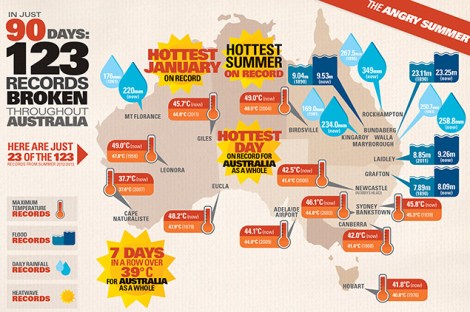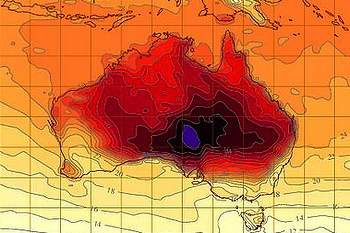
Australian Climate CommissionClick to embiggen.
Australia’s government has officially blamed climate change for the bushfires, heatwaves, and floods that ravaged the continent these past few months, during the southern hemisphere’s summer. And it gave an official name to the merciless season sent from the pits of hell: The Angry Summer.
The country set 123 weather records during what was the hottest summer on record, according to a report published this week by the federal government’s Climate Commission. Those records included the country’s hottest day, when the maximum temperature across the vast land mass on Jan. 7 averaged 104.5 degrees F. And the extreme rainfall that hit areas along the border of the states of Queensland and New South Wales in late January, when they received more than 27 inches of rain within 24 hours. And the record number of bushfires — up to 40 — that ignited on the island state of Tasmania on Jan. 4.
“Australia has always been a country of extremes, but things are getting more extreme,” Climate Commission Chair Tim Flannery said during an Australian Broadcasting Corporation interview. “This is what the climate scientists have been saying is going to happen now for several decades.”
From the commission’s website:
1. The Australian summer over 2012 and 2013 has been defined by extreme weather events across much of the continent, including record-breaking heat, severe bushfires, extreme rainfall and damaging flooding. Extreme heatwaves and catastrophic bushfire conditions during the Angry Summer were made worse by climate change.
2. All weather, including extreme weather events is influenced by climate change. All extreme weather events are now occurring in a climate system that is warmer and moister than it was 50 years ago. This influences the nature, impact and intensity of extreme weather events.
3. Australia’s Angry Summer shows that climate change is already adversely affecting Australians. The significant impacts of extreme weather on people, property, communities and the environment highlight the serious consequences of failing to adequately address climate change.
4. It is highly likely that extreme hot weather will become even more frequent and severe in Australia and around the globe, over the coming decades. The decisions we make this decade will largely determine the severity of climate change and its influence on extreme events for our grandchildren.
5. It is critical that we are aware of the influence of climate change on many types of extreme weather so that communities, emergency services and governments prepare for the risk of increasingly severe and frequent extreme weather.
Well, at least autumn has arrived and Australians have finally made it through the freakish hell of an angry summer — this year.
Flannery shared this warning: “If we continue with business as usual, by the end of the century this will look like a very moderate summer.”

Australian Climate CommissionClick to embiggen.



